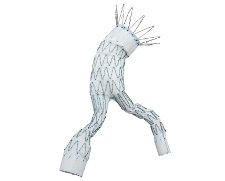
Categorised under:
Interventional Radiology
>
Vascular
>
aortic stent grafts
The aim of the study was to evaluate the anatomic suitability for endovascular abdominal aneurysm repair (EVAR) according to instructions for use (IFUs) of three commercially available bifurcated stent graft devices and explore the possible benefits of low-profile delivery systems. Computed tomography scans of 241 patients with abdominal aortic aneurysm (AAA) were evaluated for suitability of Zenith Flex, Gore Excluder and Endurant bifurcated stent graft systems according to their IFUs.
Credits: PubMed, Vascular. 2013 Mar 21. [Epub ahead of print]
Between September 1998 and October 2003, 143 patients underwent elective endovascular aneurysm repair (EVAR) using the Cook Zenith endograft. Data from these patients were reviewed from a prospective database in October 2008. Primary outcome measures were overall survival, intervention-free survival, and freedom from aneurysm rupture. Secondary outcome measures were early and late postoperative complications, including endoleaks.
Credits: J Vasc Surg. 2011 Jul;54(1):48-57.
Aneurysmal disease of the arterial vasculature has been reported since ancient times. Regarding aneurysms of the aorta, a steady progress has been made ranging from making such pathology amenable to surgical treatment to making the procedure much less invasive. There have been a number of stent grafts, introduced by different companies, used to exclude different segments of the aneurysmal aorta and the Zenith devices are one of them. The safety and efficacy of these devices to exclude infrarenal and descending thoracic aortic aneurysms has been well documented. The early and late complications associated with these procedures and the methods used to manage such complications have also been elucidated in different publications. In dealing with pararenal and thoracoabdominal aneurysms, the need to ensure patency of the visceral vessels while still repairing the aorta to healthy tissue must be considered. Strategies involving fenestrations and side-arm branches have evolved extending the ability to treat the entire aorta with an endovascular approach. Challenges exist including the inherent tortuosity and mobility of the aortic arch, close approximation of the supra-aortic vessels, small or multiple renal vessels, the commonly noted arcuate ligament compression of the celiac artery, but great strides have been made and virtually all pathologies have been addressed. The desire for smaller delivery systems has spurred interest in low-profile devices. This manuscript is intended to address the latest developments and clinical results for endovascular grafting of the aorta.
Credits: J Cardiovasc Surg (Torino). 2010 Aug;51(4):503-14

Did you know you can Register for FREE with this website?
Registration gives you full access to all of the features of WhichMedicalDevice. Find out more ...
WhichMedicalDevice is a FREE resource created by clinicians for clinicians.
Registration is free and gives you unlimited access to all of the content and features of this website.
Find out more...Registration is free and gives you unlimited access to all of the content and features of Which Medical Device. Find out more...
Which Medical Device is a community of clinicians sharing knowledge and experience of the devices and procedures we use on a daily basis. We ask that our members register with us so that we can maintain the unbiased and independent nature of our content. Registration is quick and free.
We do not make your details available to any third parties nor do we send unsolicited emails to our members. You can read our Privacy Policy here.